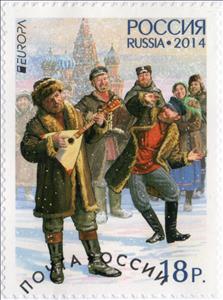Stamp: Europa Issue. Musical Instruments (Russia 2014)
Europa Issue. Musical Instruments (Russia 2014)
30 April (Russia ) within release Europa 2014 - Musical Instruments goes into circulation Stamp Europa Issue. Musical Instruments face value 18 Russian ruble
| Stamp Europa Issue. Musical Instruments in catalogues | |
|---|---|
| Michel: | Mi:RU 2041 |
| WADP Numbering System - WNS: | WAD:RU 054.14 |
Stamp is vertical format.
Designer: S. Ulyanovsky. The postage stamp depicts a scene of Russian folk festivities with people singing, dancing and playing musical instruments.Also in the issue Europa 2014 - Musical Instruments:
- Stamp - Europa Issue. Musical Instruments face value 18;
- Mini Sheet - Europa Issue. Musical Instruments face value 216;
Stamp Europa Issue. Musical Instruments it reflects the thematic directions:
A musical instrument is a device created or adapted to make musical sounds. In principle, any object that produces sound can be considered a musical instrument—it is through purpose that the object becomes a musical instrument. A person who plays a musical instrument is known as an instrumentalist. The history of musical instruments dates to the beginnings of human culture. Early musical instruments may have been used for rituals, such as a horn to signal success on the hunt, or a drum in a religious ceremony. Cultures eventually developed composition and performance of melodies for entertainment. Musical instruments evolved in step with changing applications and technologies.
The European Conference of Postal and Telecommunications Administrations (CEPT) was established on June 26, 1959, as a coordinating body for European state telecommunications and postal organizations. The acronym comes from the French version of its name Conférence européenne des administrations des postes et des télécommunications.
Folklore is the body of expressive culture shared by a particular group of people; it encompasses the traditions common to that culture, subculture or group. These include oral traditions such as tales, proverbs and jokes. They include material culture, ranging from traditional building styles to handmade toys common to the group. Folklore also includes customary lore, the forms and rituals of celebrations such as Christmas and weddings, folk dances and initiation rites. Each one of these, either singly or in combination, is considered a folklore artifact. Just as essential as the form, folklore also encompasses the transmission of these artifacts from one region to another or from one generation to the next. For folklore is not taught in a formal school curriculum or studied in the fine arts. Instead these traditions are passed along informally from one individual to another either through verbal instruction or demonstration. The academic study of folklore is called folkloristics.
Dance is an art form, often classified as a sport, consisting of sequences of body movements with aesthetic and often symbolic value, either improvised or purposefully selected. Dance can be categorized and described by its choreography, by its repertoire of movements or by its historical period or place of origin. Dance is typically performed with musical accompaniment, and sometimes with the dancer simultaneously using a musical instrument themselves.



